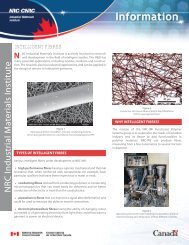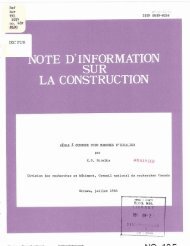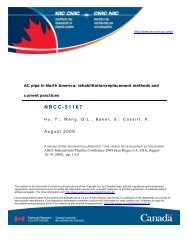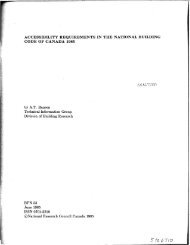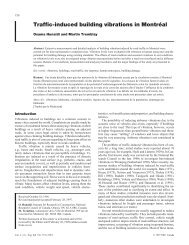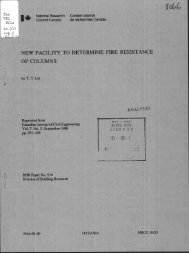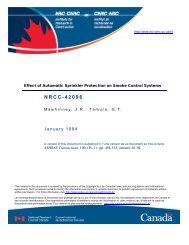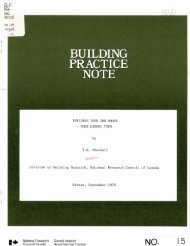Performance of pavement crack sealants in cold urban conditions
Performance of pavement crack sealants in cold urban conditions
Performance of pavement crack sealants in cold urban conditions
- No tags were found...
Create successful ePaper yourself
Turn your PDF publications into a flip-book with our unique Google optimized e-Paper software.
398 Can. J. Civ. Eng. Vol. 26, 1999Table 5. Open<strong>in</strong>g <strong>of</strong> routs <strong>in</strong> a 1-year cycle (<strong>in</strong> mm). *RoutMeanwidth Orientation † M<strong>in</strong>. Max. Range Mean 1 ‡ Mean 2 § open<strong>in</strong>g ,%12 T –0.17 0.63 0.80 1.82 1.73 14 (6)–0.24 1.25 1.49–0.54 0.81 1.35–1.29 1.61 2.90 24–0.68 1.89 2.57L –0.00 1.24 1.24 1.62–0.24 0.66 0.90–0.95 0.99 1.94–0.24 2.17 2.4119 T –0.74 2.06 2.80 3.09 2.83 15–1.04 2.47 3.51–0.53 1.81 2.34–0.71 1.97 2.68–1.65 2.81 4.46 23–0.40 2.33 2.73L –0.33 1.70 2.03 2.06 (11)–0.55 1.54 2.0940 T –0.40 3.37 3.77 3.62 3.41 8–0.63 3.79 4.42 11–0.37 2.50 2.87–1.39 1.57 2.96–0.41 2.98 3.39–0.91 3.40 4.31L –1.12 1.25 2.37 2.79 (6)–0.61 2.60 3.21* From open<strong>in</strong>g <strong>in</strong> April when the weekly average temperature was 7°C.† T, transverse; L, longitud<strong>in</strong>al.‡ Mean accord<strong>in</strong>g to orientation and rout width.§ Mean accord<strong>in</strong>g to rout width. Mean percent open<strong>in</strong>g (mean 2 / rout width).Max. (m<strong>in</strong>.)open<strong>in</strong>g, %rout size comb<strong>in</strong>ation was compared and qualified as low,medium, or high. The results are shown <strong>in</strong> Table 6. Unexpectedly,they revealed that <strong>sealants</strong> <strong>in</strong> routs <strong>of</strong> 12 × 12 mm 2debonded less than <strong>sealants</strong> <strong>in</strong> routs <strong>of</strong> 40 × 10 mm 2 .Based on numerical models (Kuri and Tons 1992; Tons1962; Wang and Weisgerber 1993), <strong>sealants</strong> <strong>in</strong> 40 mm widerouts, with a width-to-height ratio, W/H, <strong>of</strong> 4 should haveperformed better than <strong>sealants</strong> <strong>in</strong> 12 or 19 mm wide routs,with W/H = 1. Factors peculiar to field <strong>conditions</strong>, not <strong>in</strong>cluded<strong>in</strong> the models, are most likely responsible for the discrepancybetween the observed and expected performances.Some factors can readily be excluded. Table 5 shows, for example,that differences <strong>in</strong> percent <strong>crack</strong> open<strong>in</strong>g and associatedtensile stresses cannot account for the discrepancy.Sealants <strong>in</strong> 40 mm wide routs had been exposed to only halfthe extension <strong>of</strong> other <strong>sealants</strong>. Sealant adhesion at the routbottom also does little to expla<strong>in</strong> the <strong>in</strong>consistency, as it canonly account for greater cohesive failure due to an <strong>in</strong>crease<strong>in</strong> stress immediately above the <strong>crack</strong> (Wang and Weisgerber1993). Moreover, the relative adhesion area amongst therouts had been held constant by adjust<strong>in</strong>g the ratio routwidth to <strong>crack</strong> width to about 3. Consequently, factors otherthan sealant adhesion to asphalt concrete and the tensile(compressive) stress <strong>in</strong>duced by the <strong>crack</strong> open<strong>in</strong>g (clos<strong>in</strong>g)<strong>in</strong>fluenced sealant performance.Sealant ag<strong>in</strong>g and unaccounted shear stresses at the <strong>sealants</strong>urface can expla<strong>in</strong> the discrepancy between the observedand expected performances. Wider <strong>sealants</strong> aresubjected to more weather<strong>in</strong>g and may age more quickly.Sealants can lose a substantial amount <strong>of</strong> plasticiz<strong>in</strong>g oilwith<strong>in</strong> a s<strong>in</strong>gle year (Masson and Lacasse 1997) and the relativeloss <strong>of</strong> oil may be greater <strong>in</strong> the largest sealant. In the<strong>urban</strong> sett<strong>in</strong>g, the shear stress at the sealant surface possiblyplay a dom<strong>in</strong>ant role, however. With the current practice, thesealant is most <strong>of</strong>ten leveled with the <strong>pavement</strong> surface.Consequently, it may be sheared by tires from vehicles thatmove slowly, stop, accelerate, and turn while <strong>in</strong> contact withthe sealant surface. The large surface and the exposure <strong>of</strong>the 40 mm wide sealant to shear stresses would also expla<strong>in</strong>its tendency towards greater pull-out levels (Table 6).<strong>Performance</strong> trendsIn service, <strong>sealants</strong> do not rema<strong>in</strong> unchanged as they areexposed to water, sunlight, and freez<strong>in</strong>g and thaw<strong>in</strong>g cycles.They weather like other bitum<strong>in</strong>ous materials (M<strong>in</strong>karah etal. 1992; Petersen 1984). As a result, they may harden(Bahia and Anderson 1991) and loose elasticity <strong>in</strong> <strong>cold</strong> temperatures.For that reason, <strong>sealants</strong> are sometimes selectedbased on field tests, the one-year test be<strong>in</strong>g most common(Pearson and Lynch 1992). Figure 1, with a trend typical <strong>of</strong>© 1999 NRC Canada
Masson et al. 399Table 6. Frequency <strong>of</strong> failure levels <strong>in</strong> differentrouts. *Debond<strong>in</strong>g † Pull-out †Sealant 12 19 40 12 19 40A L M H L M HB L M H L H HC M L H H M LD L M H L H ME L M H H L HF M L H H L MG L M H M L HH M L H H L MJ M L H H L MK L M H L H HL H L H M H LM M L H L H HTotalsH 0 0 12 4 5 6M 5 6 0 2 2 4L 6 6 0 5 5 2* 12:12×12mm 2 ;19:19×19mm 2 ;40:40×10mm 2 .† L, M, and H represent low, medium, and high failurelevels, respectively.Fig. 1. Typical failure pr<strong>of</strong>ile for a sealant <strong>in</strong> the various routs.the observed time-dependent performance, shows that sealantfailure did not <strong>in</strong>crease l<strong>in</strong>early and that a one-year testwould have failed to accurately predict a longer-term performance.The <strong>in</strong>crease <strong>in</strong> sealant failure could typically be divided<strong>in</strong> three stages. The <strong>in</strong>itial stage, a steeply ris<strong>in</strong>g slope,covered the first year <strong>of</strong> service. This stage was followed bya period <strong>of</strong> nearly two years where pull-out lengths rema<strong>in</strong>edfairly constant. In the f<strong>in</strong>al stage, from 32 months to44 months <strong>in</strong> the example, the failure <strong>in</strong>creased aga<strong>in</strong>, withthat <strong>in</strong> the 12 mm wide rout exceed<strong>in</strong>g that <strong>in</strong> the others.The change <strong>in</strong> sealant performance is evidently morecomplex than anticipated. The group<strong>in</strong>g <strong>of</strong> 66 failure curves(eleven <strong>sealants</strong>, three rout geometries, two orientations)such as those <strong>in</strong> Fig. 1 allowed for highlight<strong>in</strong>g recurrenttrends. These are shown <strong>in</strong> Figs. 2 and 3. Pull-out trendswere labeled P1 to P4 (Fig. 2) and debond<strong>in</strong>g trends were labeledD1 to D4 (Fig. 3). In the best case, failure levels rema<strong>in</strong>edlow and <strong>in</strong>creased quasi-l<strong>in</strong>early (P1, P2, D3). Incontrast, failure could reach a plateau after a one- or twoyearperiod <strong>of</strong> rapid failure (P3, D4). In cases where f<strong>in</strong>alfailure levels were high (D1, D2, P4), <strong>in</strong>itial sealant failurewas high and the plateau was short.The exact reasons for the changes <strong>in</strong> failure rates rema<strong>in</strong>unknown, but they are likely l<strong>in</strong>ked to specific components<strong>in</strong> the sealant – asphalt concrete system, namely, the <strong>in</strong>terfaceand the sealant itself. Excessive sealant stiffness and aweak <strong>in</strong>terface may be responsible for the <strong>in</strong>itial and rapid<strong>in</strong>crease <strong>in</strong> debond<strong>in</strong>g. A weak <strong>in</strong>terface may result from <strong>in</strong>terfacialdefects such as micro<strong>crack</strong>s at the asphalt concretesurface and voids due to dust or <strong>in</strong>complete sealant wett<strong>in</strong>g.Sealant weather<strong>in</strong>g and stiffen<strong>in</strong>g may be responsible for thelater <strong>in</strong>crease <strong>in</strong> debond<strong>in</strong>g. On this ground, an extendedfirst phase would be characteristic <strong>of</strong> stiff <strong>sealants</strong>, or alternatively<strong>of</strong> an aged and brittle <strong>pavement</strong>, whereas an extendedsecond phase, a long plateau, would be characteristic<strong>of</strong> a better sealant.Sealant selection for long-term performanceTo estimate long-term performance and rank the twelve<strong>sealants</strong>, the 4-year pull-out and debond<strong>in</strong>g levels were considered.For that purpose, a performance <strong>in</strong>dex was calculated.A simple addition <strong>of</strong> the respective debond<strong>in</strong>g andpull-out levels would have implied that both types <strong>of</strong> failureswere equally damag<strong>in</strong>g to <strong>pavement</strong>s, and would haveunderestimated the effect <strong>of</strong> pull-outs on <strong>pavement</strong> degradation.Consequently, pull-out lengths were given more weightthan debond<strong>in</strong>g lengths <strong>in</strong> the determ<strong>in</strong>ation <strong>of</strong> a performance<strong>in</strong>dex. To that effect, the follow<strong>in</strong>g equation wasused:PI=100–(D + nP)where PI is the sealant performance <strong>in</strong>dex; D is the percentdebonded length <strong>of</strong> the sealant; P is the percent pull-outlength; and n is an <strong>in</strong>teger that accounts for the effect <strong>of</strong>pull-outs over debond<strong>in</strong>g on performance.Given that the absence <strong>of</strong> sealant over 1m<strong>of</strong><strong>crack</strong> mayallow the <strong>in</strong>gress <strong>of</strong> sand and stones that can damage the<strong>pavement</strong> dur<strong>in</strong>g its expansion (Peterson 1982), and also allowthe penetration <strong>of</strong> much more water than a simple sealantdebond<strong>in</strong>g over the same length, a value <strong>of</strong> n = 4 wasthought reasonable. The approach is admittedly simplisticand the choice <strong>of</strong> n subjective, but it allowed us to fairly appreciatethe performance <strong>of</strong> the <strong>sealants</strong> and it made for aneasy comparison <strong>of</strong> the <strong>in</strong>dividual performances (values <strong>of</strong> n< 4 provided a similar rank<strong>in</strong>g <strong>of</strong> materials but the difference<strong>of</strong> PI between the <strong>sealants</strong> was somewhat reduced).Accord<strong>in</strong>gly, <strong>sealants</strong> could be ranked <strong>in</strong> decreas<strong>in</strong>g order<strong>of</strong> field performance and the performance compared toASTM test results (Table 7). Little correlation between fieldand laboratory test results could be found, which is consistentwith the work <strong>of</strong> others (Lynch and Janssen 1997). Seal-© 1999 NRC Canada
400 Can. J. Civ. Eng. Vol. 26, 1999Fig. 2. Pull-out trends for <strong>sealants</strong> <strong>in</strong> Montreal. The trendsoccurred with equal frequency.Table 7. Sealant acceptance based on standard andfield tests.Sealant<strong>Performance</strong><strong>in</strong>dex4-yearperformanceH 75 Good NoB 74 YesE 72 NoF 65 Average NoM 64 YesL 54 YesD 54 YesJ 39 Poor NoK 35 YesA 33 NoC † 10 Very poor NoG 8 No* From Table 1.† After one year <strong>of</strong> service.ASTMacceptance *Fig. 3. Debond<strong>in</strong>g trends for <strong>sealants</strong> <strong>in</strong> Montreal. Occurrenceswere 40%, 8%, 33%, and 19% for trends D1, D2, D3, and D4,respectively.ants H and E, which showed good field performance, failedto meet the requirements <strong>of</strong> the specification. In contrast,Sealant K, which met the standard requirements, showedpoor field performance. In the end, average performers (e.g.,Sealants M, L, D) were more likely to meet the ASTMD3405 specification than <strong>sealants</strong> at the performance limits,the good and the poor <strong>sealants</strong>. The usefulness <strong>of</strong> the specification<strong>in</strong> select<strong>in</strong>g good <strong>sealants</strong>, those required for demand<strong>in</strong>g<strong>conditions</strong>, may thus be questioned. The results forpenetration can be especially mislead<strong>in</strong>g. It has been shownby Lu and Isacsson (1997) that there is little correlation betweenthe performance <strong>of</strong> polymer-modified bitumens, e.g.,<strong>crack</strong> <strong>sealants</strong>, and their penetration values. The exist<strong>in</strong>gspecification limits the penetration to 90 dmm but three <strong>of</strong>the four best performers <strong>in</strong> this study exceeded that limit.ConclusionsTwelve bitum<strong>in</strong>ous <strong>crack</strong> <strong>sealants</strong> were <strong>in</strong>stalled <strong>in</strong> routs<strong>of</strong>12×12mm 2 ,19×19mm 2 ,and40×10mm 2 (width ×depth), and evaluated over 4 years <strong>in</strong> an <strong>urban</strong> sett<strong>in</strong>g withair temperatures rang<strong>in</strong>g from –40°C to +40°C. The <strong>pavement</strong>,<strong>in</strong> which <strong>crack</strong> open<strong>in</strong>g ranged from 6% to 24%, wasa bitum<strong>in</strong>ous overlay with a concrete base. The short-term(1-year) and mid-term (4-year) debond<strong>in</strong>g and pull-out levelswere compared; the effect <strong>of</strong> rout size on performancewas determ<strong>in</strong>ed; failure trends were identified, and overallperformance was compared with standard test results.Sealant performance was found to vary tremendouslyfrom one product to the next. The four-year debond<strong>in</strong>g levelsvaried from 0 to 50% whereas pull-out levels varied from0 to 30%, depend<strong>in</strong>g on sealant shape (rout size) and <strong>crack</strong>orientation. Relative failure levels <strong>of</strong>ten correlated with sealantwidth, overall performance <strong>in</strong>creas<strong>in</strong>g <strong>in</strong> the order40 mm < 19 mm < 12 mm. The trend follows the <strong>in</strong>creasedexposure <strong>of</strong> <strong>sealants</strong> to weather<strong>in</strong>g and slow mov<strong>in</strong>g traffic.Sealant debond<strong>in</strong>g and pull-out did not <strong>in</strong>crease l<strong>in</strong>early,as three stages were identified <strong>in</strong> the time–failure curve. Instage 1, failure <strong>in</strong>creased rapidly. In stage 2, little failure occurredand <strong>in</strong> stage 3, failure <strong>in</strong>creases aga<strong>in</strong> but at a slowerrate than <strong>in</strong> stage 1. Failures <strong>in</strong> stage 1 are thought to be relatedto a weak sealant – asphalt concrete <strong>in</strong>terface whereasthose <strong>of</strong> stage 3 are thought to be related to sealant weather<strong>in</strong>gand stiffen<strong>in</strong>g.It was also found that <strong>sealants</strong> with either good or poorfield performance failed to meet the requirements <strong>of</strong> theASTM D3405 specification. Sealants demonstrat<strong>in</strong>g averageperformance were more likely to meet the specification.In corollary to this study, it can be said that <strong>crack</strong> seal<strong>in</strong>gis still an evolv<strong>in</strong>g technique. This method <strong>of</strong> preventivema<strong>in</strong>tenance has been shown to extend the service life <strong>of</strong>rapid ways, which translates <strong>in</strong>to economic benefits. These© 1999 NRC Canada
Masson et al. 401benefits are identical <strong>in</strong> the <strong>urban</strong> sett<strong>in</strong>g, but the service<strong>conditions</strong> are different. For maximum benefits, it is requiredthat sealant <strong>in</strong>stallation be adapted to <strong>urban</strong> <strong>conditions</strong>and that <strong>in</strong>stallations suitable for rapid ways not beused <strong>in</strong>discrim<strong>in</strong>ately <strong>in</strong> the city, the rout size be<strong>in</strong>g a case<strong>in</strong> po<strong>in</strong>t. The exist<strong>in</strong>g sealant specification also does little toprovide maximum benefits. To select <strong>sealants</strong> adapted to thedemand<strong>in</strong>g <strong>cold</strong> <strong>urban</strong> <strong>conditions</strong>, a performance-basedspecification is required.ReferencesBahia, H.U., and Anderson, D.A. 1991. Isothermal lowtemperaturephysical harden<strong>in</strong>g <strong>of</strong> asphalt cements. Proceed<strong>in</strong>gs<strong>of</strong> the International Symposium on Chemistry <strong>of</strong> Bitumens,Rome, Italy, Vol. 1, pp. 114–147.Belangie, M.C., and Anderson, D.I. 1985. Crack seal<strong>in</strong>g methodsand materials for flexible <strong>pavement</strong>s. Utah Department <strong>of</strong> Transportation,Salt Lake City, Utah, Report FHWA/UT-85/1.Chai, J. 1989. Crack seal<strong>in</strong>g test program. 1986 test <strong>sealants</strong>, f<strong>in</strong>alreport. Pavement Managements Systems, The City <strong>of</strong> EdmontonTransportation Department, Edmonton, Alta.Chehovits, J., and Mann<strong>in</strong>g, M. 1984. Materials and methods forseal<strong>in</strong>g <strong>crack</strong>s <strong>in</strong> asphalt concrete <strong>pavement</strong>s. TransportationResearch Record 990, Transportation Research Board, Wash<strong>in</strong>gton,D.C., pp. 12–19.City <strong>of</strong> Montreal. 1991. Specifications for <strong>crack</strong> seal<strong>in</strong>g <strong>in</strong>Montreal. Public Works Service, Montreal, Que.Eaton, R.A., and Ashcraft, J. 1992. State-<strong>of</strong>-the-art survey <strong>of</strong> flexible<strong>pavement</strong> <strong>crack</strong> seal<strong>in</strong>g procedures <strong>in</strong> the United States.Cold Regions Research & Eng<strong>in</strong>eer<strong>in</strong>g Laboratory, U.S. ArmyCorps <strong>of</strong> Eng<strong>in</strong>eers, Hanover, N.H., Report 9218.Erickson, D.E. 1992. Crack seal<strong>in</strong>g effectiveness. Wash<strong>in</strong>gtonState Department <strong>of</strong> Transportation, Wash<strong>in</strong>gton, D.C., ReportWA-RD256.1.Evers, R.C. 1981. Evaluation <strong>of</strong> <strong>crack</strong>-seal<strong>in</strong>g compounds forasphaltic <strong>pavement</strong>s. Ontario M<strong>in</strong>istry <strong>of</strong> Transportation andCommunications, Toronto, Ont., Project No. 33, Interim ReportNo. 1.Hubrecht, L. 1986. Réparation des jo<strong>in</strong>ts de construction dans lesrevêtements asphaltiques. Centre de recherches routières,Brussels, Belgium.Khuri, F.M., and Tons, E. 1992. Compar<strong>in</strong>g rectangular and trapezoidalseals us<strong>in</strong>g the f<strong>in</strong>ite element method. TransportationResearch Record 1334, Transportation Research Board, Wash<strong>in</strong>gton,D.C., pp. 25–37.Knight, N.E. 1985. Seal<strong>in</strong>g <strong>crack</strong>s <strong>in</strong> bitum<strong>in</strong>ous overlays <strong>of</strong> rigidbases. Transportation Research Record 1041, TransportationResearch Board, Wash<strong>in</strong>gton, D.C., pp. 75–81.LCPC. 1981. Scellement des fissures. Laboratoire Central desPonts et Chaussées, Paris, France.Lu, X., and Isacsson, U. 1997. Characterization <strong>of</strong> styrenebutadiene-styrenepolymer modified bitumens — comparison <strong>of</strong>conventional methods and dynamic mechanical analyses. Journal<strong>of</strong> Test<strong>in</strong>g and Evaluation, 25(4): 383–390.Lupien, C., Roireau, M., and Véz<strong>in</strong>a, D. 1987. Crack seal<strong>in</strong>g: anevaluation <strong>of</strong> a few compounds and a variety <strong>of</strong> application<strong>conditions</strong>. Pav<strong>in</strong>g <strong>in</strong> Cold Areas, 1(3): 689–718.Lynch, L.N., and Janssen, D.J. 1997. Sealant specifications: past,present, and future. Proceed<strong>in</strong>gs <strong>of</strong> the Pavement Crack andJo<strong>in</strong>t Sealants for Rigid and Flexible Pavements Conference,United States Army Eng<strong>in</strong>eer Waterways Experiment Station,Airfields and Pavements Division, Vicksburg, Miss., pp. 5–23.Masson, J-F. 1997. Effective seal<strong>in</strong>g <strong>of</strong> <strong>pavement</strong> <strong>crack</strong>s <strong>in</strong> <strong>cold</strong> <strong>urban</strong>environments. Institute for Research <strong>in</strong> Construction,National Research Council Canada, Ottawa, Ont.Masson, J-F., and Lacasse, M.A. 1997. Towards a performancebasedspecification for bitum<strong>in</strong>ous <strong>crack</strong> <strong>sealants</strong> used <strong>in</strong> <strong>urban</strong><strong>conditions</strong>. Proceed<strong>in</strong>gs <strong>of</strong> the Pavement Crack and Jo<strong>in</strong>tSealants for Rigid and Flexible Pavements Conference, UnitedStates Army Eng<strong>in</strong>eer Waterways Experiment Station, Airfieldsand Pavements Division, Vicksburg, Miss., pp. 152–167.Masson, J-F., and Lacasse, M.A. 1999. The effect <strong>of</strong> the hot-airlance on the adhesion <strong>of</strong> <strong>sealants</strong> used <strong>in</strong> roadway ma<strong>in</strong>tenance.Journal <strong>of</strong> Transportation Eng<strong>in</strong>eer<strong>in</strong>g, 125: In press.Masson, J-F., Lauzier, C., Coll<strong>in</strong>s, P., and Lacasse, M.A. 1998.Sealant degradation dur<strong>in</strong>g the <strong>crack</strong> seal<strong>in</strong>g <strong>of</strong> <strong>pavement</strong>s. Journal<strong>of</strong> Materials <strong>in</strong> Civil Eng<strong>in</strong>eer<strong>in</strong>g, 10(4): 250–255.M<strong>in</strong>karah, I., Cook, J.P., and Rajogopal, A.S. 1992. Applicability<strong>of</strong> artificial weather<strong>in</strong>g tests for performance evaluation <strong>of</strong>elastomeric <strong>sealants</strong>. In Science and technology <strong>of</strong> build<strong>in</strong>gseals, <strong>sealants</strong>, glaz<strong>in</strong>g, and waterpro<strong>of</strong><strong>in</strong>g. Vol. 2. ASTM STP1200. Edited by J.M. Klosowski. American Society for Test<strong>in</strong>gand Materials, Philadelphia, Pa.Pearson, D.C., and Lynch, D.F. 1992. The quality <strong>of</strong> rubberizedasphalt <strong>crack</strong> sealer for asphalt <strong>pavement</strong>s supplied <strong>in</strong> 1991.Ontario M<strong>in</strong>istry <strong>of</strong> Transportation, Toronto, Ont., Report MI-154.Petersen, J.C. 1984. Chemical composition <strong>of</strong> asphalt as related toasphalt durability: state <strong>of</strong> the art. Transportation Research Record999, Transportation Research Board, Wash<strong>in</strong>gton, D.C.,pp. 13–30.Peterson, D.E. 1982. Reseal<strong>in</strong>g jo<strong>in</strong>ts and <strong>crack</strong>s <strong>in</strong> rigid and flexible<strong>pavement</strong>s. NCHRP Synthesis <strong>of</strong> Highway Practice 98,Transportation Research Board, Wash<strong>in</strong>gton, D.C.Quebec M<strong>in</strong>istry <strong>of</strong> Transportation. 1996. Specifications for <strong>crack</strong>seal<strong>in</strong>g <strong>in</strong> the Prov<strong>in</strong>ce <strong>of</strong> Quebec. Québec, Que.Smith, K.L., and Rom<strong>in</strong>e, A.R. 1993. Materials and procedure forseal<strong>in</strong>g and fill<strong>in</strong>g <strong>crack</strong>s <strong>in</strong> asphalt-surfaced <strong>pavement</strong>s. StrategicHighway Research Program, National Research Council,Wash<strong>in</strong>gton, D.C., Report SHRP-H-348.Tessier, G.R. 1990. Guide de construction et d’entretien deschaussées. Association Québecoise des Travaux Routiers,Montreal, Que.Tons, E. 1962. Geometry <strong>of</strong> simple jo<strong>in</strong>t seals under stra<strong>in</strong>. Newjo<strong>in</strong>t <strong>sealants</strong>: criteria, design, and materials. PublicationNo. 1006, Build<strong>in</strong>g Research Institute, Wash<strong>in</strong>gton, D.C.,pp. 41–61.Wang, C.P., and Weisgerber, F.E. 1993. Effects <strong>of</strong> seal geometryon adhesive stresses <strong>in</strong> <strong>pavement</strong> jo<strong>in</strong>t seals. TransportationResearch Record 999, Transportation Research Board,Wash<strong>in</strong>gton, D.C., pp. 64–70.Ward, D.R. 1993. Evaluation <strong>of</strong> <strong>crack</strong> sealant performance onIndiana’s asphalt concrete surfaced <strong>pavement</strong>s. Indiana Department<strong>of</strong> Transportation, Indianapolis, Ind.© 1999 NRC Canada




